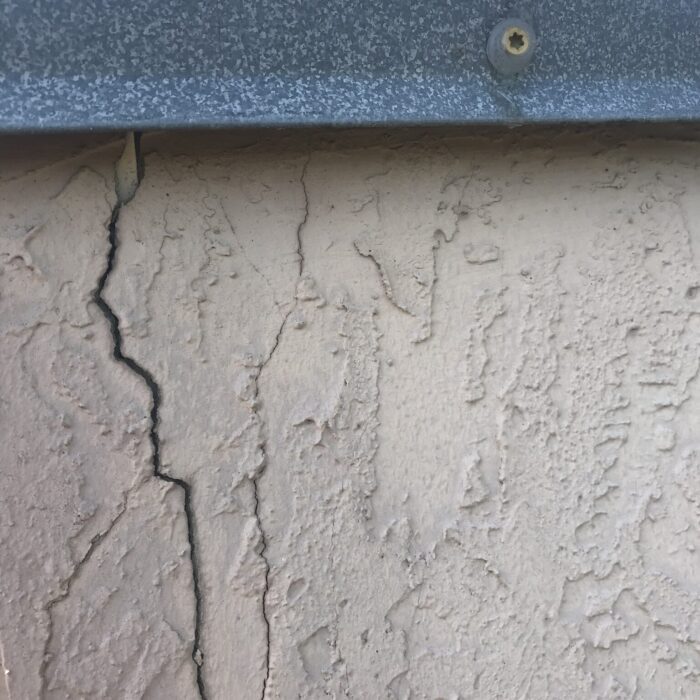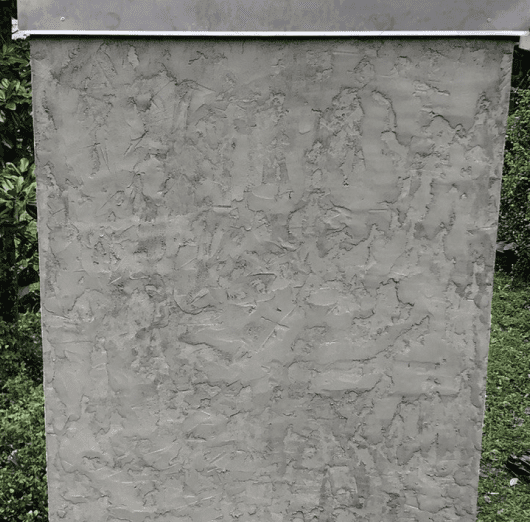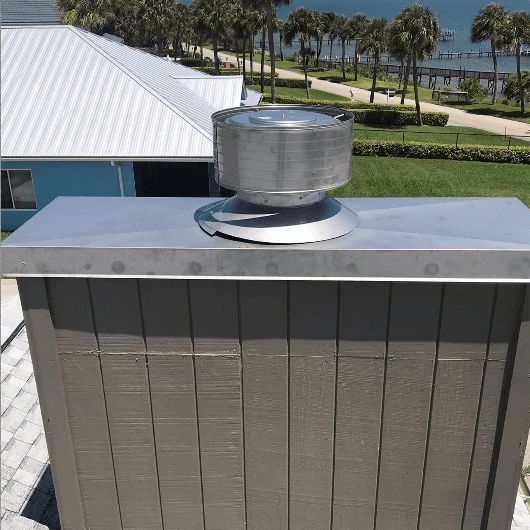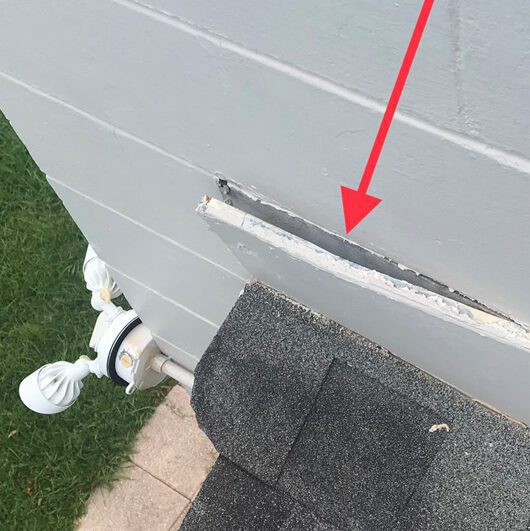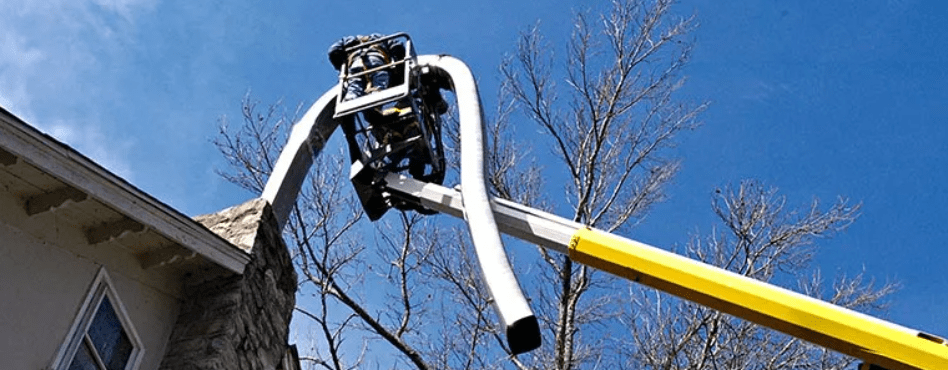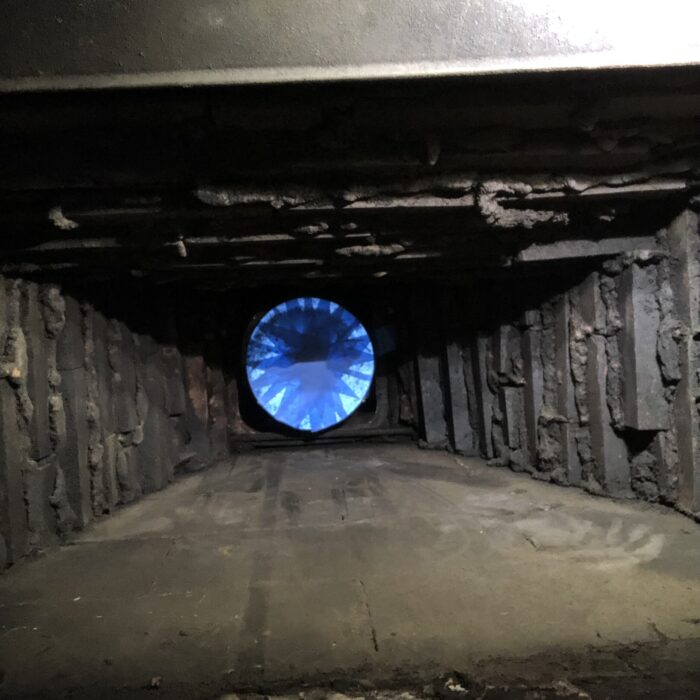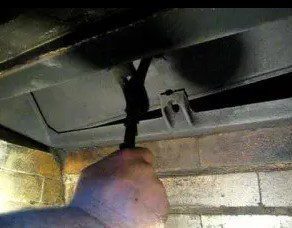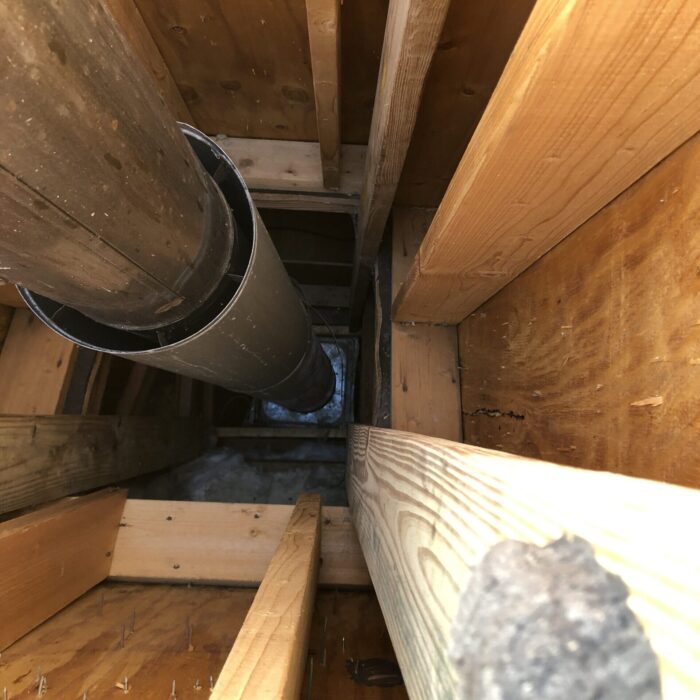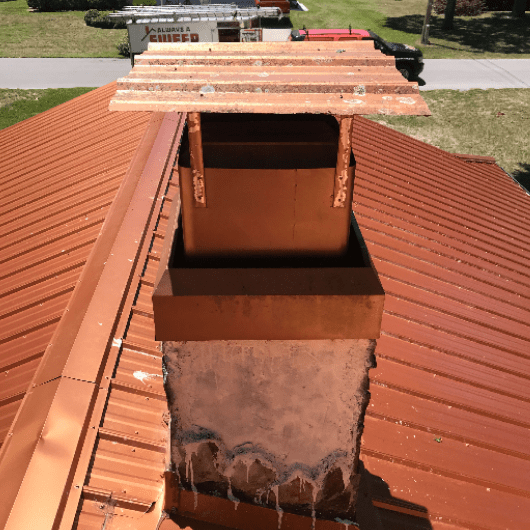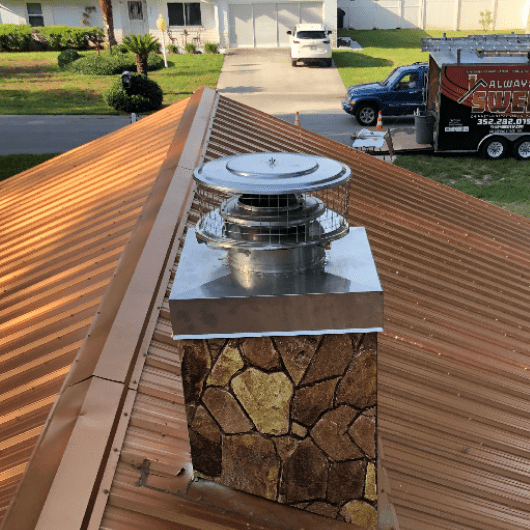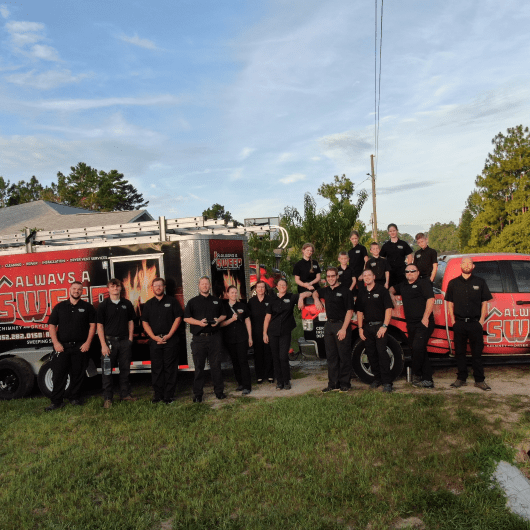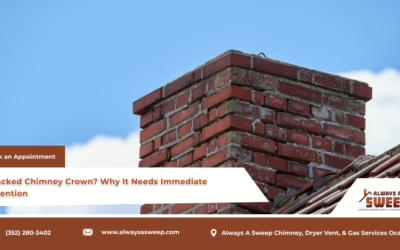Keeping Your Home Safe, One Chimney at a Time
At Always a Sweep, we understand that a chimney isn’t just a structural feature—it’s a part of your home that keeps your family warm and safe. Over the years, we’ve seen countless homes where a minor leak turned into a major issue.
Leaky Chimney
If you see leaking around the chimney, don’t call a roofer!
Always A Sweep Certified Chimney Professional can identify the cause of the leak and recommend safe ways to repair it without putting your home at risk.
Chimneys can leak in more than one area at a time. Often these leaks go undetected for some time. Here are 9 of the most common areas that we find leaks (and it’s usually more than one):
- Missing or damaged chimney flue cap/spark arrestor
- Inadequate flue tile extension
- Cracked and failing crown or splay
- Breeched splay expansion joint
- Undersized or deteriorated chase cover
- Missing storm collar or breeched storm collar seal
- Inadequate water intrusion protection from aging mortar joints
- Missing “cricket” or chimney “saddle”
- Poorly designed or deteriorated flashing
Have our certified technicians conduct a Water Intrusion Assessment for your chimney today. A Water Intrusion Assessment is included in part of every Level 2 inspection and can be completed as a separate service where appropriate. Contact us for details.
Chimney Cap
Like your head, protect your chimney with a properly fitted cap designed for your chimney!
You can tell if your chimney cap may need some TLC by looking from street level at the top of your chimney for rusting or damage.
Chimney caps are often called spark arrestors because one of their important jobs is to break down larger sparks that fly up the chimney into smaller sparks that have a better chance at cooling before they hit your roof or trees nearby. Chimney caps also help protect your internal chimney flue liner from rain, leaves, debris, birds, and critters. And they also help protect those same birds and critters from accidentally (or purposely-some of them are ornery critters) entering and getting trapped in your chimney. Chimney caps can also prevent water from pouring into the chimney flue, damaging the interior of the flue liner and structure over time.
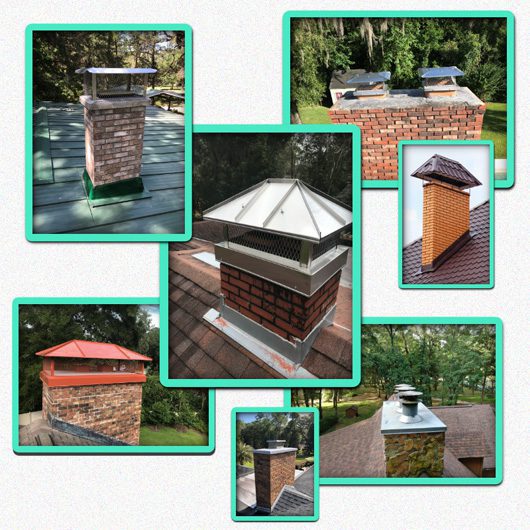
Certain types of caps provide better protection than others or cover more area and are better than others for certain situations. However, some chimney caps can make a fireplace much more dangerous to use. You can trust our Certified Chimney Professionals to recommend the appropriate cap or cap type for your specific fireplace and chimney type.
NOTE: We do not install “universal” fit chimney caps. If you have ever seen one installed, you probably understand why!
Types of stainless steel and copper chimney caps we offer:
- Materials: Copper, Stainless Steel Premium, and Stainless Steel Powder Coated (wide variety of Colors)
- Colors: Powder coating Stainless Steel allows for a wide variety of colors
- Secured Type: Flue Mount, Crown Mount, and Multi Flue, or Full Cover Skirt Mounted Caps
- Decorative Styles: Hip and Ridge and Standing Seam, Gable, Bell, Concave, Crown, Cathedral, French, Georgian, Wagon, Barrel, Chimney Pot Styles (variety)
You can tell if your chimney cap may need some TLC by looking from street level at the top of your chimney for rusting or damage.
Chimney caps are often called spark arrestors because one of their important jobs is to break down larger sparks that fly up the chimney into smaller sparks that have a better chance at cooling before they hit your roof or trees nearby. Chimney caps also help protect your internal chimney flue liner from rain, leaves, debris, birds and critters. And they also help protect those same birds and critters from accidentally (or purposely-some of them are ornery critters) entering and getting trapped in your chimney. Water can also pour into the chimney flue damaging the interior of the flue liner and structure over time.
Certain types of caps provide better protection than others or cover more area and are better than others for certain situations. However, some chimney caps can make a fireplace much more dangerous to use. You can trust our Certified Chimney Professionals to recommend the appropriate cap or cap types depending on the specific fireplace and chimney type that will provide the best protection for your home and won’t make your fireplace more dangerous to use.
NOTE: We do not install “universal” fit chimney caps. If you have ever seen one installed you’d understand why?
Types of stainless steel and copper chimney caps we offer:
- Materials: Copper, Stainless Steel Premium, and Stainless Steel Powder Coated (wide variety of Colors)
- Colors: Powder coating Stainless Steel allows for a wide variety of colors
- Secured Type: Flue Mount, Crown Mount, and Multi Flue, or Full Cover Skirt Mounted Caps
- Decorative Styles: Hip and Ridge and Standing Seam, Gable, Bell, Concave, Crown, Bell, Cathedral, French, Georgian, Wagon, Barrel, Chimney Pot Styles (variety)
Chase Cover
A chase cover is used for a ‘prefabricated’ or factory built fireplace that has a wood framed chase enclosure, often mistakenly called a “chimney” because they look almost identical.
A chase cover fits over the top of the chimney chase enclosure. They’re sometimes called “caps”, “chase caps”, “chase flashings”, or “top pans” because they top chimneys that are often sided with vinyl, metal, wood, ceramic fiber board, and even brick facades or stone. When properly sized and installed (unfortunately, not common here in Florida) these chase covers can provide essential water intrusion prevention that these wood frame chimneys rely on.
Often leaking from a poorly constructed or installed chase cover goes undetected for years, until a severe storm illuminates this weakness with water intrusion into an area of the home near the fireplace or even further away. Our Certified Chimney Professionals are trained in properly sizing custom chimney chase covers for optimum home protection against even Florida’s severe wind driven rains.
Our stainless steel chase covers:
- Prevent water intrusion through the top of the chase or chimney chase.
- Protect against rust and staining on the side of the chimney, roof, and home resulting from water pooling on the cover.
- Come with a lifetime transferable warranty if you sell your house.
Before
After
Before
After
A chase cover fits over the top of the chimney chase enclosure. Sometimes called “caps”, “chase caps”, “chase flashings”, or “top pans” because they top chimneys that are often sided with vinyl, metal, wood, ceramic fiber board, and even brick facades or stone. When properly sized and installed (unfortunately, not common here in Florida) these chase covers can provide essential water intrusion prevention that these wood frame chimneys rely on.
Often leaking from a poorly constructed or installed chase cover goes undetected for years until a severe storm illumines this weakness with water intrusion into an area of the home near the fireplace or even further away. Our Certified Chimney Professionals are trained in properly sizing custom chimney chase covers for optimum home protection against even Florida’s severe wind driven rains.
Our stainless steel chase covers:
- Prevent water intrusion through the top of the chase or chimney chase.
- Protect against rust and staining on the side of the chimney, roof, and home resulting from water pooling on the cover.
- Come with a lifetime transferable warranty if you sell your house.
Chimney Flashing & Roofing
At first glance, you might see our work as flashy, but when you look closer, you will see we have the quality nailed down.
Chimney flashing is the custom formed metal that is designed to seal out water between the chimney structure and the roof.
When your flashing has worn out over time or if it was improperly installed, water can get into your attic and home. A majority of construction and remodeling in Central and North Central Florida over the last 40 years have utilized an easier, faster, cheaper way of flashing chimneys which has resulted in more regular flashing failure.
There are 5 major deficiencies that our Certified Chimney Technicians find every day on these Florida roofs that you don’t typically see on older Florida homes that have 60-80 year old flashing that is still doing its job:
Deficiency 1
Rusting metals- Instead of using copper, aluminum, stainless steel, or lead flashing, a painted or galvanized flashing is used that only provides protection until it rusts through. Because much of the base flashing is buried under the shingles and stays wet regularly, it rusts rather quickly and is difficult to inspect without removing shingles. There are other indicators that our qualified inspectors look for to identify age and deterioration levels of hidden flashing.
Deficiency 2
One piece flashing (instead of two piece) with no allowance for expansion of the roof and masonry separately. This is a little more complicated, but it has to do with expansion rate differences in the wooden parts of the roofing and much less flexible brick or block. This inflexibility causes failure regularly.
Deficiency 3
Relying on caulking or sealants to keep water out instead of an imbedded mechanical joint/seam- In a short period of time the Florida sun devours any type of exposed sealant. Quick flashing jobs rely on sealants to get the job done fast, and the homeowner is left with leaks just a few years (often sooner) down the road when that sealant starts to break down. Often this will be pin holes that slowly open up allowing more and more water into the attic area until finally a homeowner notices spots on the ceiling. Often by this time damage has been done to other areas.
Deficiency 4
Missing or non-embedded counter (2nd piece) flashing- this type of counter flashing relies on a sealant. Some installations are better than others, but all of them are only as good as the sealant applied and as long as the Florida sun plays nice.
Deficiency 5
Embedded counter flashing installation failures- whether from poorly designed counter flashing (without a “z” bend) or just not being sunk deep enough, this type of failure typically manifests after a few years of movement through expansion and contraction of the metal and the masonry, though we have seen it breeched within days of installation.
Whatever the deficiencies identified, our certified technicians can provide effective solutions to last a lifetime. Properly installed base and counter flashing should not have to be replaced again in the lifetime of the homeowner.
Chimney Relining
Does your chimney suck? Like a straw with holes that doesn’t suck, a chimney liner cannot properly draft (suck) if there are hidden holes or cracks. It also cannot protect your home like it needs to.
A chimney liner is the first line of defense for the home. In most masonry constructed chimney systems, the liner is made of vitreous fire clay tiles 3/4 inch- 1 1/8 inch thick. When installed properly and intact without holes and cracks, it can provide the first 2 of 4 lines of defense for your home, taking dangerous gasses to the atmosphere and minimizing heat transfer to nearby combustible framing materials.
Many fireplaces are used regularly with these hidden deficiencies without warning until it is too late. If your inspection doesn’t include an internal image or video scan of the chimney interior, then your chimney inspector is missing potentially hazardous conditions that only an internal camera can pick up.
These are some of the most common and most dangerous deficiencies that we find in the flue regularly through industry standard internal image capturing chimney scans:
- Incomplete chimney liner. This is when the liner is missing in a section because the builder didn’t have enough on the job and decided that no one would find out.
- Completely missing mortar joints are often found in homes that have not had a flue cap for more than 10 years at some point in their lifespan. However, we have found homes less than 5 years old with this deficiency even with the claims: “This builder used only the best subcontractors.”
- Holes in mortar joints are small holes from poor workmanship or inappropriate materials in combination with water intrusion leave the home without an intact liner and unprotected.
- No chimney liner.
- Broken liners are visible as hairline or larger cracks when cooled, but when heated, they open up. These tiles break from the outside in when thermally shocked with a rapid heat increase, such as from a “free burning chimney flue fire” or “slow burning chimney flue fire,” or other significant thermal event, or lightning strike. Many of these events often go undetected and will usually not be identified without an internal image scan of the liner.
When a chimney liner is damaged there may be multiple industry options for repair (slip casting or coating) or replacement, but depending on original construction, the most common requirement is relining with a UL 1777 liner listed to zero clearance for fire safety. You can trust our Certified Chimney Reliners (CCP/CCR) to recommend the right range of options suitable for your particular chimney construction to ensure your home stays safe while you burn.
Smoke Chamber
Funneling your fireplace’s smoke up and out.
Serving as a gateway to the chimney flue, a smoke chamber sits just above the firebox and damper. It is intended to serve as an upside-down funnel for your smoke to travel, but is often built in a way that inhibits gasses from escaping efficiently, causing a backup of smoke into the home. Often this area can be “finished” or reformed to a more aerodynamic shape with insulated reinforced refractory mortar to vastly increase performance.
Since this area is the cause of many house fires because of improper construction hidden from view, even smaller holes and cracks difficult to see can lead to disastrous consequences for the home and occupants. Industry standards, NFPA 211, and Florida Building code require that at minimum this area be parged smooth. When UL listed zero clearance refractory products are used properly for this, additional home protection against those hidden hazards are also addressed.
If you have been getting smoke in your living room while you enjoy your fireplace or just haven’t had a proper inspection done in the last year, contact Always A Sweep to inspect your smoke chamber as part of our standard NFPA Level 2 inspection.
Before
After
Before
After
Serving as a gateway to the chimney flue, a smoke chamber sits just above the firebox and damper. It is intended to serve as an upside-down funnel for your smoke to travel, but is often built in a way that inhibits gases from escaping efficiently causing a back up of smoke into the home. Often this area can be “finished” or reformed to a more aerodynamic shape with insulated reinforced refractory mortar to vastly increase performance.
Since this area is the cause of many house fires because of improper construction hidden from view, even smaller holes and cracks difficult to see can lead to disastrous consequences for the home and occupants. Industry standards, NFPA 211, and Florida Building code require that at minimum this area be parged smooth. When UL listed zero clearance refractory products are used properly for this, additional home protection against those hidden hazards are also addressed.
If you have been getting smoke in your living room while you enjoy your fireplace or just haven’t had a proper inspection done in the last year, contact Always A Sweep to inspect your smoke chamber as part of our standard NFPA Level 2 inspection.
Damper Repair
If your damper starts talking back and giving you lip, give us a call. We can shut it up!
A properly operating damper (often mistakenly called a “flue,” “flute,” “flume,” or “thingy”) opens up the fireplace throat and allows smoke to pass into the smoke chamber. When the fireplace is not operating and the embers have been fully extinguished, closing the damper will minimize loss of conditioned air from the home saving you potentially hundreds or even thousands of dollars a year on your home’s electric bill.
Leaving a damper open – or partially open because it won’t shut properly – can cause energy loss equivalent to leaving your front door open ¾ of an inch all year long. Often we get calls for dampers that are not cooperating and causing smoke to spill into the home because they won’t fully open.
If you are getting smoke into the home or just can’t get that damper to properly shut, our certified technicians can make adjustments to put dampers back on track. And, when dampers are either deteriorated or so poorly constructed that they require removal and replacement, we can provide the best range of options for your home.
If your damper starts talking back and giving you lip, give us a call. We can shut it up!
Wood Framed Chimney Chase
SURPRISE, SURPRISE, SURPRISE!
Many chimney chases in our service area are constructed of wood framing with various siding materials, including stucco, rock, brick facades or stamped brick stucco facades, sheet metal, wood siding, and cement fiber board. Some siding materials hold up better than others as well as help to keep water out of the home longer, depending on construction.
Many homeowners are surprised to find out that their “Masonry Chimney” is actually a wood framed chimney chase enclosure with stucco or rock or brick siding. Since masonry siding materials (stucco, rock, brick facades or stamped brick stucco facades) don’t expand and move as freely as the wood framed chase nailed to the roof decking, they crack or become dislodged over time especially when exposed to Florida’s severe weather conditions.
Our certified technicians conduct Water Intrusion Assessments as part of every inspection. We identify current and future problem areas to help keep the structure from damage, and when repairs are necessary, as a Florida Certified Contractor (#CRC1333200), we can repair or rebuild it!
Many chimney chases in our service area are constructed of wood framing with various siding materials, including stucco, rock, brick facades or stamped brick stucco facades, sheet metal, wood siding, and cement fiber board. Some siding materials hold up better than others as well as help to keep water out of the home longer, depending on construction.
Many homeowners are surprised to find out that their “Masonry Chimney” is actually a wood framed chimney chase enclosure with stucco or rock or brick siding. Since masonry siding materials (stucco, rock, brick facades or stamped brick stucco facades) don’t expand and move as freely as the wood framed chase nailed to the roof decking, they crack or become dislodged over time especially when exposed to Florida’s severe weather conditions.
Our certified technicians conduct Water Intrusion Assessments as part of every inspection to identify current and future problem areas to help keep the structure from damage and when repairs are necessary. As a Florida Certified Contractor (#CRC1333200), we can repair or rebuild it!
Masonry Repair
Q: Did that third little pig ever need masonry repair?
A: Since our favorite little pig story ended after the demise of the wolf trying to enter the home through the chimney, many homeowners were never told that eventually the 3rd little pig had to do exterior maintenance and some minor chimney repairs. After its many years of enduring exposure to Florida’s harsh weather, it wasn’t in great shape. When the chimney was hit by lightning the 2nd time, he had to rebuild part of it (and reline it). Maybe that was a later released sequel book that had a happy ending, as his insurance paid for the repairs under his standard home insurance policy!
If that little pig would have called Always A Sweep soon after building the home, our certified technicians could have provided options for preventative maintenance that would have ensured that he would have not had to spend time repairing his chimney. Then, he would have had more time to spend at the market!
Contact Always A Sweep if you notice:
- loose bricks or stones
- cracks in the mortar
- discoloration on the brick
- vines growing on the chimney
- your chimney looks wet shortly after a rain
Or even better, take a lesson from the 3rd pig and call us earlier for an assessment and preventative maintenance.
Chimney Rebuild
We can rebuild your chimney stronger and better than before.
Sometimes chimney damage goes further than just needing minor repairs or repointing. This is when chimneys have to be fully (or partly) rebuilt to address a specific deficiency to protect your home.
When this is necessary and whatever the need, our Certified Chimney Professionals are here to help!
Before
After
Before
After
Sometimes chimney damage goes further than just needing minor repairs or repointing. This is when chimneys have to be fully (or partly) rebuilt to address a specific deficiency to protect your home.
When this is necessary and whatever the need, our Certified Chimney Professionals are here to help!
Why Choose Us
- Licensed Professionals: Our team is fully licensed and trained to handle all types of gas services with the highest level of expertise. We hold a Certified Category V Gas License (LI45277).
- Safety First: We prioritize your safety in every job we undertake, adhering to all safety regulations and standards.
- Quality Workmanship: We take pride in our work, ensuring that every job is completed to the highest standards of quality and reliability.
- Customer Satisfaction: Your satisfaction is our top priority. We strive to provide exceptional customer service and stand behind our work.
Contact Us
If you need professional gas services for your home, look no further than Always A Sweep & Home Repair. Contact us today to schedule an appointment or to learn more about our services. You can reach us at 352-310-8315.
Blogs
Chimney Flashing Repair Florida: How Always A Sweep Stops Roof Leaks Before They Start
Roof leaks are one of the most frustrating and costly issues for homeowners. While damaged shingles often get the blame, a hidden but common cause of roof leaks is faulty chimney flashing. If the...
Chimney Fire Prevention in Florida
Many Florida homeowners love the charm and warmth of a fireplace. But what most people overlook is that even in the Sunshine State, your chimney can become a hidden fire hazard without proper care....
Cracked Chimney Crown? Why It Needs Immediate Attention
Your chimney does more than just enhance your home’s appearance—it plays a critical role in ventilation and safety. One of the most vulnerable components of your chimney system is the chimney crown,...

